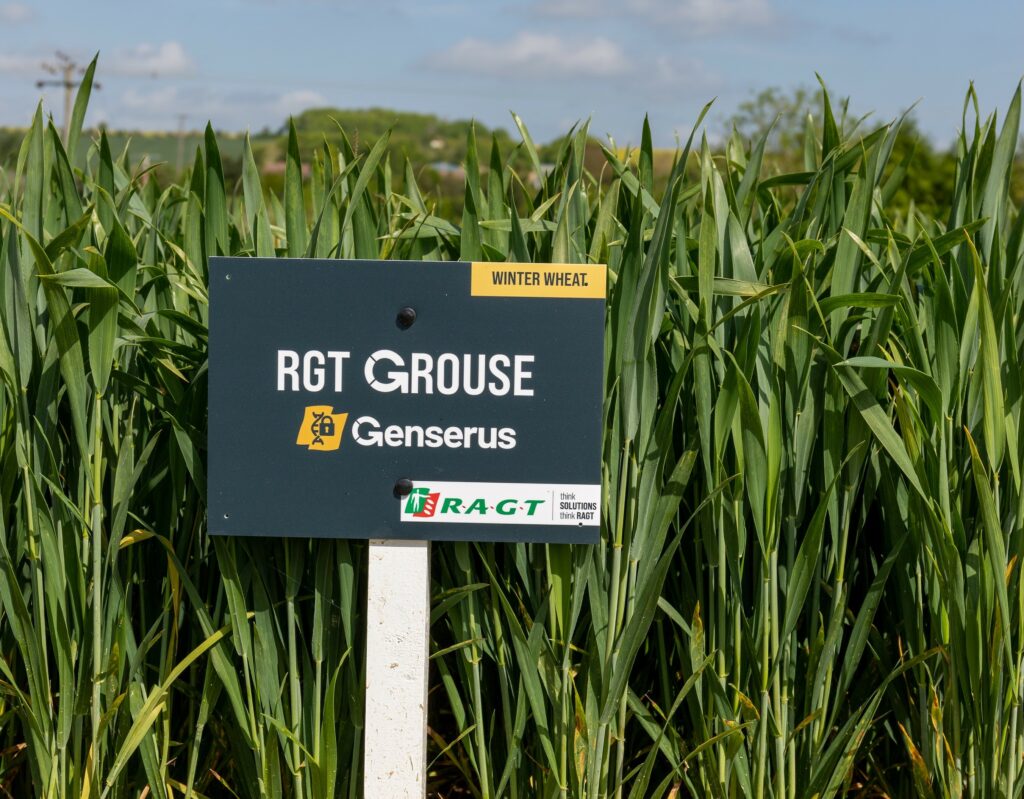The increasing threat of barley yellow dwarf virus in winter wheat and the potential of resistant varieties to overcome it was the focus of a recent open day at TWB Farms, near Lichfield.
Host farmer Clive Bailye set up an observation trial last autumn, comparing 15ha of BYDV-resistant RGT Grouse with a similar area of Dawsum. Clive, who started the farm’s no-till/cover crop regime 16 years ago, hasn’t used insecticides in that time. “We’ve not had any noticeable symptoms or yield loss, apart from occasional hotspots under hedges and trees, but are we losing yields from sub-clinical disease?
“That’s one reason I’m keen to find out more about BYDV-resistant wheat. I also I want to maintain my no-insecticide policy, and the trait is even more interesting now we can receive £45/ha under SFI where we don’t use insecticides on crops.”
How much he will learn from his trial this year is unclear. Despite large numbers of aphids being recorded in the area, very few were seen in crops and BYDV symptoms are absent. “The general consensus is that the wet autumn reduced aphid numbers,” said Clive, who intends to follow up next year with a split field trial, using qPCR testing to pick up any sub-clinical presence. RAGT managing director Lee Bennett says unprotected crops can suffer severe damage when aphid numbers are high. “BYDV is the single most damaging pest of winter cereals,” he added.
According to AHDB figures 82% of the UK wheat area is susceptible to BYDV and the average annual loss would be 8% if no action was taken against the disease.
“We’ve artificially recreated that situation at our breeding station in Cambridge, applying inoculated aphids to plots of our own BYDV-resistant wheats and several popular conventional varieties,” Lee said. “None were sprayed with insecticide. The BYDV-resistant varieties were untouched, but we saw 2% to 60% yield loss in the conventional ones. At the upper end it’s not worth getting the combine out.”
He added: “Neonicotinoids gave fantastic control of aphids for two decades, but after their withdrawal in 2019 we’re left with often prophylactic applications of pyrethroids as the only chemical control.”

However, RAGT’s Genserus (BYDV-resistant) varieties offer complete season-long control, whilst providing economic and environmental benefits, ease of management and security he said (see table).
In addition, currently available varieties (see panels) offer a real opportunity to claim the £45/ha SFI payment for insecticide-free crops thanks to their double resistance to BYDV and orange wheat blossom midge.
“Genserus varieties offer the best control of BYDV, do not affect the environment and are cost effective,” Lee said. “The trait element costs around £14/ha, the equivalent of buying and applying just one pyrethroid spray.”
BYDV control
Currently, growers who choose to spray are totally reliant on pyrethroids, said entomologist Dr Alan Dewar.
“Nothing else is registered for use in the autumn at the moment, so this must change,” he says. “The risk of selection for resistance is very high.”
Of the two main aphid vectors of BYDV, the bird cherry-oat aphid is controlled well by pyrethroids, although resistant/tolerant clones have recently been recorded in Ireland and China.
By contrast, resistant grain aphids were first recorded in 2009, and control failures have been reported in four years since then, most recently in 2023.
Quoting Dr Stephen Foster of Rothamsted Research, Dr Dewar said: “Whilst currently a moderate resistance, it will become important if lower rates of pyrethroids are applied and/or coverage is inadequate.”
Non-chemical methods for reducing BYDV are available, he added. “Delaying drilling until the aphid threat is diminished works well – aphids do eventually stop flying through November and in December. But late drilling can result in reduced yields and getting crops drilled in the first place is also subject to inclement weather, as in 2019 and 2023.”
Conservation control, such as flowering margins that encourage predators like hover flies, has helped to put an end to major epidemics of grain aphids in wheat ears in the summer, Dr Dewar believes. “However, it is less easy to rely on predators in the autumn, when virus transmission is the main threat.”
The use of BYDV resistant/tolerant varieties has worked well in barley. “This should be regarded the best approach as you don’t need pesticide at all,” he notes. “The big question is whether yields can match the top conventional varieties – there have been problems with that in barley, for example.”
However, Dr Dewar added; “Epidemics of aphids carrying BYDV are occurring more often in the autumn due to global warming, causing BYDV infection the following spring.”
If regulatory pressure on chemistry increases and aphid resistance climbs, might BYDV-resistant crops be the only solution?
Genserus varieties available this autumn
RGT Grouse
- Group 4 type hard feed wheat
- Resistant to BYDV and OWBM
- Suitable for early sowing when BYDV risk is highest
- High tillering capacity and retention
- Good disease resistance
- Very good yield potential
RGT Goldfinch
- The UK’s first quality wheat resistant to BYDV and OWBM
- Very strong disease profile – best in official trials
- Clean, consistent, and sustainable
- Excellent baking quality to date
- Strong miller interest
- RL Candidate variety – accelerated production means seed is available.



